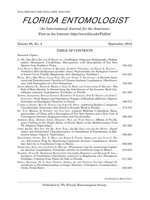We studied the effects of crude extracts and fractions of Azadirachta indica, Melia azedarach, Toona ciliata and Trichilia pallida on both egg and nymph mortality and embryonic development of Bemisia tabaci B biotype, using tomato plants grown in a greenhouse. Next, we studied the host selection behavioral effects on the adult whitefly under laboratory conditions. The dichloromethane extracts from all plant species and fractions of the extract from branches of T. pallida (EBTPD) and of the extract from leaves of T. ciliata (ELTCD) in dichloromethane caused mortality of nymphs, but neither affected egg viability. However, the branches of the ethanolic extract of A. indica increased the period of embryonic development of the B. tabaci. In addition, the tomato leaflets treated with the fraction of ELTCD dichloromethane (0.28%) were the least preferred by adults, reducing the number of insects resting on the tomato leaflets. The ELTCD methanol and EBTPD dichloromethane fractions inhibited B. tabaci oviposition. Thus, Meliaceae derivatives can contribute to the reduction of the B. tabaci population. The susceptibility of the B. tabaci to Meliaceae derivatives and the relevant behavioral changes of this pest are discussed.
How to translate text using browser tools
1 September 2012
Insecticidal and Behavioral Effects of Secondary Metabolites from Meliaceae On Bemisia tabaci (Hemiptera: Aleyrodidae)
Gerane Celly Dias Bezerra-Silva,
Márcio Alves Silva,
José Djair Vendramim,
Carlos Tadeu Dos Santos Dias

Florida Entomologist
Vol. 95 • No. 3
September 2012
Vol. 95 • No. 3
September 2012
Azadirachta indica
Melia azedarach
mosca-branca
Toona ciliata
Trichilia pallida
whitefly




